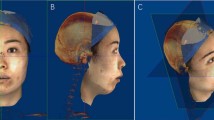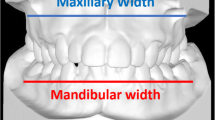Abstract
Objectives
This study seeks to three-dimensionally assess soft tissue changes in the orofacial region following tooth-borne and bone-borne surgically assisted rapid maxillary expansion (SARME).
Materials and methods
This prospective cohort study included 40 skeletally mature patients with transverse maxillary hypoplasia. A tooth-borne distractor (Hyrax) was used for expansion in 25 patients. In the remaining 15, a bone-borne distractor (transpalatal distractor, TPD) was used. Cone beam computed tomography (CBCT) scans were acquired before treatment (T0) and 22 months later (T1). 3D models were constructed from CBCT data and superimposed using voxel-based matching. Distance maps between the superimposed 3D models were computed to evaluate the degree of skeletal and soft tissue changes in the maxillary region.
Results
Distance maps showed negative distances (mean −1.25 (±1.5) mm) in the middle of the upper lip, indicating posterior repositioning of this area. The cheek region showed positive changes (mean 1.66 (±1.1) mm), reflecting the underlying increase in maxillary width. There was no significant difference between the two groups in all measured distances (p > 0.05). Retro-positioning of the upper lip accompanied skeletal remodeling in the anterior alveolar region at a mean ratio of 88 %, while the cheek region followed 32 % of the alveolar expansion.
Conclusion
Soft tissue changes following SARME include posterior repositioning of the upper lip and increased projection of the cheek area. These changes were comparable between bone-borne and tooth-borne appliances.
Clinical relevance
This study provides clinicians with more information over the expected orofacial soft tissue changes following SARME



Similar content being viewed by others
References
Mommaerts MY (1999) Transpalatal distraction as a method of maxillary expansion. Br J Oral Maxillofac Surg 37:268–272
Lagravere MO, Major PW, Flores-Mir C (2006) Dental and skeletal changes following surgically assisted rapid maxillary expansion. Int J Oral Maxillofac Surg 35:481–487
Landes CA, Laudemann K, Schubel F, Petruchin O, Mack M, Kopp S, Sader RA (2009) Comparison of tooth- and bone-borne devices in surgically assisted rapid maxillary expansion by three-dimensional computed tomography monitoring: transverse dental and skeletal maxillary expansion, segmental inclination, dental tipping, and vestibular bone resorption. J Craniofac Surg 20:1132–1141
Zemann W, Schanbacher M, Feichtinger M, Linecker A, Karcher H (2009) Dentoalveolar changes after surgically assisted maxillary expansion: a three-dimensional evaluation. Oral Surg Oral Med Oral Pathol Oral Radiol Endod 107:36–42
Laudemann K, Petruchin O, Nafzger M, Ballon A, Kopp S, Sader R, Landes C (2010) Long-term 3D cast model study: bone-borne vs. tooth-borne surgically assisted rapid maxillary expansion due to secondary variables. Oral Maxillofac Surg 14:105–114
Swennen GRJ, Mollemans W, Schutyser F (2009) Three-dimensional treatment planning of orthognathic surgery in the era of virtual imaging. J Oral Maxillofac Surg 67:2080–2092
Nada RM, Maal TJJ, Breuning KH, Bergé SJ, Mostafa YA, Kuijpers-Jagtman AM (2011) Accuracy and reproducibility of voxel based superimposition of cone beam computed tomography models on the anterior cranial base and the zygomatic arches. PLoS One 6:e16520
Christie KF, Boucher N, Chung C-H (2010) Effects of bonded rapid palatal expansion on the transverse dimensions of the maxilla: A cone-beam computed tomography study. Am J Orthod Dentofac Orthop 137:S79–S85
Nada RM, Fudalej PS, Maal TJ, Bergé SJ, Mostafa YA, Kuijpers-Jagtman AM (2012) Three-dimensional prospective evaluation of tooth-borne and bone-borne surgically assisted rapid maxillary expansion. J Craniomaxillofac Surg 40:757–762
G.R.J. Swennen FACS, J.-E. Hausamen (2005) Three-dimensional Cephalometry: A Color Atlas and Manual (Edited) Springer GmbH, Berlin
van Loon B, Maal TJ, Plooij JM, Ingels KJ, Borstlap WA, Kuijpers-Jagtman AM, Spauwen PH, Bergé SJ (2010) 3D Stereophotogrammetric assessment of pre- and postoperative volumetric changes in the cleft lip and palate nose. Int J Oral Maxillofac Surg 39:534–540
Berger JL, Pangrazio-Kulbersh V, Thomas BW, Kaczynski R (1999) Photographic analysis of facial changes associated with maxillary expansion. Am J Orthod Dentofac Orthop 116:563–571
Ramieri GA, Nasi A, Dell’Acqua A, Verzé L (2008) Facial soft tissue changes after transverse palatal distraction in adult patients. Int J Oral Maxillofac Surg 37:810–818
Kau CH, Richmond S (2008) Three-dimensional analysis of facial morphology surface changes in untreated children from 12 to 14 years of age. Am J Orthod Dentofac Orthop 134:751–760
Cevidanes LHC, Heymann G, Cornelis MA, DeClerck HJ, Tulloch JFC (2009) Superimposition of 3-dimensional cone-beam computed tomography models of growing patients. Am J Orthod Dentofac Orthop 136:94–99
Heymann GC, Cevidanes L, Cornelis M, De Clerck HJ, Tulloch JFC (2010) Three-dimensional analysis of maxillary protraction with intermaxillary elastics to miniplates. Am J Orthod Dentofacial Orthop 137:274–284
Cattaneo PM, Treccani M, Carlsson K, Thorgeirsson T, Myrda A, Cevidanes LHS, Melsen B (2011) Transversal maxillary dento-alveolar changes in patients treated with active and passive self-ligating brackets: a randomized clinical trial using CBCT-scans and digital models. Orthod Craniofac Res 14:222–233
Sutherland K, Lee RWW, Phillips CL, Dungan G, Yee BJ, Magnussen JS, Grunstein RR, Cistulli PA (2011) Effect of weight loss on upper airway size and facial fat in men with obstructive sleep apnoea. Thorax 66:797–803
Kau CH, Cronin AJ, Richmond S (2007) A three-dimensional evaluation of postoperative swelling following orthognathic surgery at 6 months. Plast Reconstr Surg 119:2192–2199
Filho HN, Goncales ES, Berrentin-Felix G, de Souza CU, Achja GL (2002) Evaluation of the facial soft tissues following surgically assisted maxillary expansion associated with the simple V-Y suture. Int J Adult Orthodon Orthognath Surg 17:89–97
Altug Atac AT, Karasu HA, Aytac D (2006) Surgically assisted rapid maxillary expansion compared with orthopedic rapid maxillary expansion. Angle Orthod 76:353–359
Gungor AY, Turkkahraman H, Baykul T, Alkis H (2012) Comparison of the effects of rapid maxillary expansion and surgically assisted rapid maxillary expansion in the sagittal, vertical, and transverse planes. Med Oral Patol Oral Cir Bucal 17:e311–319
Matteini C, Mommaerts MY (2001) Posterior transpalatal distraction with pterygoid disjunction: a short-term model study. Am J Orthod Dentofacial Orthop 120:498–502
Pinto PX, Mommaerts MY, Wreakes G, Jacobs WV (2001) Immediate postexpansion changes following the use of the transpalatal distractor. J Oral Maxillofac Surg 59:994–1000
Acknowledgments
The authors would like to acknowledge Dr. Martien de Koning, who surgically treated all patients in this study.
Funding
This work was supported by a grant from the Dutch Technology Foundation (STW 10315). R. Nada was funded by the Netherlands Fellowship Program PhD studies, Netherlands Ministry of Foreign Affairs, and Netherlands Organization for International Cooperation in Higher Education (Nuffic), grant number: NFP-PhD: CF 2916/2006. The sponsors had no role in the study design; in the collection, analysis, and interpretation of data; in the writing of the manuscript; or in the decision to submit the manuscript for publication.
Conflict of interest
The authors declare that they have no conflict of interest.
Author information
Authors and Affiliations
Corresponding author
Rights and permissions
About this article
Cite this article
Nada, R.M., van Loon, B., Maal, T.J. et al. Three-dimensional evaluation of soft tissue changes in the orofacial region after tooth-borne and bone-borne surgically assisted rapid maxillary expansion. Clin Oral Invest 17, 2017–2024 (2013). https://doi.org/10.1007/s00784-013-0927-1
Received:
Accepted:
Published:
Issue Date:
DOI: https://doi.org/10.1007/s00784-013-0927-1




